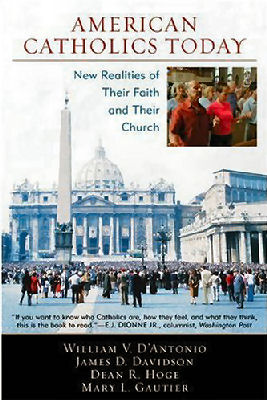
|
Posted April 2, 2007
Book: American Catholics Today: New Realities of their Faith and their Church Authors: William V. D’Antonio, James D. Davidson, Dean R. Hoge, Mary L. Gautier Rowman and Littlefield. New York. 2007. Pp. 204 An Excerpt from the jacket:
An Excerpt from the book: Actions of Church Leaders A third suggestion involves the actions of Church leaders, both clerical and lay. As occupants of highly visible leadership roles, these people have extraordinary opportunities to influence the thinking of the laity, including laypeople’s commitment to the Church. We have shown that laypeople have confidence in most local priests. By and large, they believe their parish priests are doing a good job. When conversations turn to people they admire and respect, many laypeople mention in particular priests they have known over the years. In some parishes, there are priests and sisters who are considered to be almost saintly, usually because of their exceptional personalities and their selfless efforts on behalf of their parishes. We have no doubt that these role models contribute to the laity’s commitment to the Church: “If he or she can love the Church that much, then it should be an important part of my life too.” Yet our surveys also show that Church leaders’ behavior can have detrimental effects. Laypeople were ashamed by reports that priests had violated the trust and the bodies of young Catholics, and they were angry about the way bishops mishandled these cases. The effect was an erosion of the laity’s confidence in Church leaders. What could leaders do to restore the laity’s confidence and renew its commitment? We think it is important to work on the problems that laypeople consider the most serious challenges facing the Church. According to the data, these challenges are to: – put an end to the sexual abuse of children by priest. – make sure that bishops handle any future cases of abuse more swiftly and effectively – address the growing shortage of priests – increase young adults’ participation in the Church If leaders focus their attention on addressing these problems, laypeople are likely to respond with renewed confidence in their leaders. But if leaders give their attention only to issues that laypeople consider unimportant, the laity will become more cynical and alienated from the Church. Another suggestion is to respond to the laity’s desire to be involved in decisions at virtually all levels of Church life. A priority area is sexual and reproductive ethics. Fewer and fewer laypeople believe that clergy alone should have the final say on matters such as homosexuality, the ordination of women, abortion, and contraception. Increasingly, laypeople believe that clergy and laypeople should share in decisions related to such matters. To the extent that leaders ignore the laity’s desire to think about these issues in dialogue with theologians, bishops, and other officials, they are likely to diminish the laity’s attachment to the Church. On the other hand, if they reach out to laypeople, seek their input, and take it seriously (as they did in the 1983 peace pastoral and the 1986 pastoral on economic justice), they would take an important step toward bringing laypeople into greater union with the Church. Doing so would also be consistent with the Vatican II document Lumen Gentium, which says, “The body of the faithful as a whole, anointed as they are by the Holy One, cannot err in matters of belief. Thanks to a supernatural sense of the faith which characterizes the People as a whole, it manifests this unerring quality, when, from the bishops down to the last member of the laity, it shows universal agreement in matters of faith and morals. Related to this is the laity’s involvement in issues related to personnel, finances, and Church management. Most clergy will admit that these are time-consuming responsibilities that have little to do with the sacramental and pastoral work that is at the core of their ministries. Meanwhile, highly educated, professional laypeople who have expertise in these areas are volunteering to serve, often at considerable personal cost. Canon law calls for a finance council for each parish and recommends a parish pastoral council as well. Many pastors are implementing these consultative bodies in parishes and learning a more collaborative leadership style. More than 30,000 lay ecclesial ministers now serve on parish staffs, many of them assisting with parish management tasks. The more the laypeople are involved, the stronger will be their commitment to the Church. All of these efforts require dialogue between generations, as younger and older Catholics work together to negotiate issues and solutions. They also help to bridge the communication gap that now exists between liberals and conservatives. In addition, they help clergy and laity work together on topics that are of mutual concern and solutions that address the common good. Table of Contents: 1. Introduction: Catholic laity, Catholic faith, and the Catholic Church 2. Catholic identity: analysis and trends 3. American Catholics’ commitment to the institutional Church 4. The sacraments: trends and variations 5. Problems facing the Catholic Church 6. American Catholics and church authority 7. Church leadership and lay involvement 8. Religion and politics among American Catholics 9. Conclusions: summary and implications |
|
